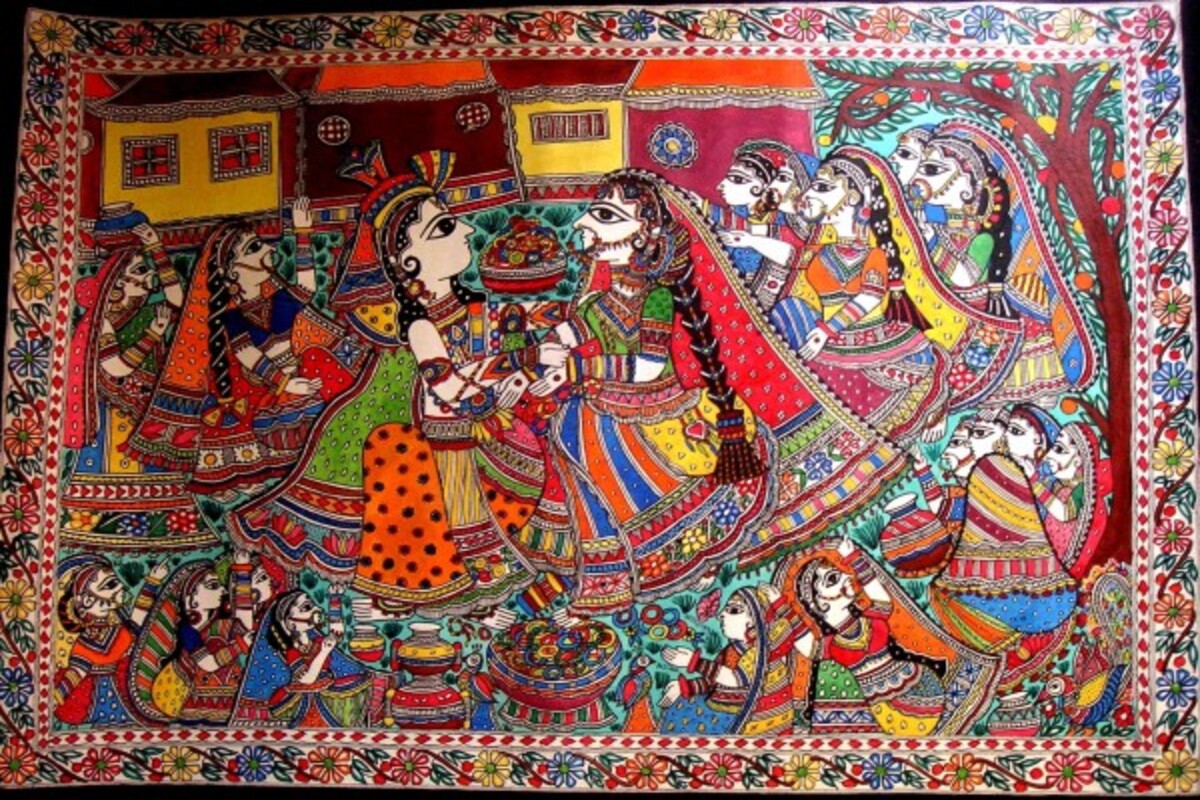History exhibition chronicling city’s past
The four-day 18th International History and Heritage exhibition will be inaugurated on 11 February at Sabarna Sangrahasala in Barisha.
One can also see Mithila painting as a movement that broke the caste barrier. These paintings are an illustration of the thoughts, hopes, and dreams of the villagers, especially the womenfolk.

Madhubani painting(photo:stock)
The art forms of Bihar are appreciated all over the world because of their great aesthetic value and their adherence to tradition. Madhubani painting is an age-old rural art form. It is practiced in the Mithila region of Bihar and parts of Nepal. Madhubani painting, also known as Mithila painting, is done using fingers, twigs, brushes, nib-pens, and match sticks. The sketches and various consumer goods are made with folk motifs of Mithila. Its main theme is traditional geometric patterns. Madhubani is a major export center for this painting.
Madhubani paintings are also well known for the representation of ritual content on special occasions like festivals and religious rituals. This particular type of art was used by the women to decorate their house walls and doors to seek God’s blessing for peace and prosperity.
According to many historian studies, Madhubani Painting originated from the Madhubani district of the Mithila region of Bihar some 2500 years ago.
Advertisement
Whereas, according to Hindu mythology, the origin of the Madhubani painting can be traced back to the Ramayana era when Sita’s father, Raja Janaka request that a large number of artists should decorate the whole kingdom with this form of art during Sita’s wedding. This is one of the reasons why the Madhubani paintings are often based on religious themes like the paintings of gods like Lord Krishna and scenes from the Ramayana era. This is one of the reasons why the Madhubani paintings are often seen in most religious households.
This art form was brought to further public attention in 1934 when the worst earthquake of magnitude 8.0 occurred in Bihar and regions of Nepal that caused widespread damage in the state. But, fortunately, this dark cloud had a silver lining. William G. Archer, the British Colonial officer of Madhubani district was the one who came across these paintings in the interior walls of houses of the region during examining the damage caused by the natural disaster. The British officer went on to publish several articles and black and white pictures of these paintings to the outer world.
This fact is not known to many but Madhubani artists use Madhubani art as a way to prevent trees from being cut down. This unique art was not created just for decorations, Madhubani artists make these paintings on trees depicting Hindu gods and strong religious beliefs in the region to prevent people from cutting them down.
Art Art and artists have suffered greatly due to improper commercialization and cheap duplication. Also, a lack of awareness among these people caused this northern Indian art to stay unnoticed for years.
There is a ritual context in the paintings for particular occasions, such as birth, marriage, and festivals such as Holi, Kali Puja, Durga Puja. The paintings mostly depict human beings and their association with nature and scenes of deities from the ancient period. Usually, these paintings include natural elements like fish, parrot, turtle, moon, sun, bamboo tree, etc. The geometric pattern is often seen symbolizing love, devotion, tradition, fertility, and prosperity.
It has five different styles, namely- Bharni, Katchi, Tantrik, Godna, and Khobar. Earlier there existed variability based on caste among painters’ styles of art. But, later with time, it has been globalized and differences among artists have been eradicated. Now, there are no differences in the work of artists of the region. They all work in all kinds of styles.
One can also see Mithila painting as a movement that broke the caste barrier. These paintings are an illustration of the thoughts, hopes, and dreams of the villagers, especially the womenfolk.
Today, Mithila paintings have gained popularity all over the world. The art form has piqued interest in art lovers from various countries like the USA, UK, Australia, Russia, and various other nations. These paintings are displayed in several museums not only all over the country but worldwide. Tokamachi Hills in Japan have a museum fully dedicated to Mithila paintings.
Advertisement